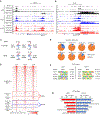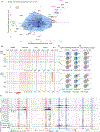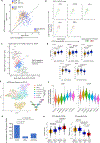Transcription factors TCF-1 and GATA3 are key factors for the epigenetic priming of early innate lymphoid progenitors toward distinct cell fates
- PMID: 35882235
- PMCID: PMC9393082
- DOI: 10.1016/j.immuni.2022.06.019
Transcription factors TCF-1 and GATA3 are key factors for the epigenetic priming of early innate lymphoid progenitors toward distinct cell fates
Abstract
The differentiation of innate lymphoid cells (ILCs) from hematopoietic stem cells needs to go through several multipotent progenitor stages. However, it remains unclear whether the fates of multipotent progenitors are predefined by epigenetic states. Here, we report the identification of distinct accessible chromatin regions in all lymphoid progenitors (ALPs), EILPs, and ILC precursors (ILCPs). Single-cell MNase-seq analyses revealed that EILPs contained distinct subpopulations epigenetically primed toward either dendritic cell lineages or ILC lineages. We found that TCF-1 and GATA3 co-bound to the lineage-defining sites for ILCs (LDS-Is), whereas PU.1 binding was enriched in the LDSs for alternative dendritic cells (LDS-As). TCF-1 and GATA3 were indispensable for the epigenetic priming of LDSs at the EILP stage. Our results suggest that the multipotency of progenitor cells is defined by the existence of a heterogeneous population of cells epigenetically primed for distinct downstream lineages, which are regulated by key transcription factors.
Keywords: ChIC-seq; EILPs; GATA3; ILCPs; PU.1; TCF-1; epigenetic priming; multipotency; scMNase-seq; single-cell epigenomics.
Published by Elsevier Inc.
Conflict of interest statement
Declaration of interests The authors declare no competing interests.
Figures




References
-
- Chea S, Schmutz S, Berthault C, Perchet T, Petit M, Burlen-Defranoux O, Goldrath AW, Rodewald HR, Cumano A, and Golub R (2016). Single-Cell Gene Expression Analyses Reveal Heterogeneous Responsiveness of Fetal Innate Lymphoid Progenitors to Notch Signaling. Cell Rep 14, 1500–1516. - PubMed
Publication types
MeSH terms
Grants and funding
LinkOut - more resources
Full Text Sources
Research Materials

